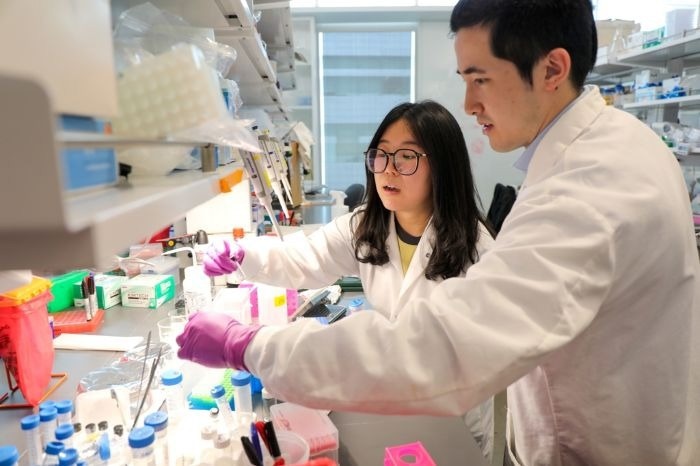Reviewed by Lexie CornerMay 15 2025
Researchers at Oregon Health & Science University have developed a new type of nanoparticle designed to improve the effectiveness and safety of ultrasound-based cancer therapies, while also helping to prevent tumor recurrence.
 Li Xiang, Ph.D., postdoctoral scholar at the OHSU Knight Cancer Institute, and Michael Henderson, B.A., biomedical engineering Ph.D. student, are part of a team that developed a new nanoparticle that makes cancer treatment safer and more effective. Image Credit: Oregon Health & Science University/Christine Torres Hicks
Li Xiang, Ph.D., postdoctoral scholar at the OHSU Knight Cancer Institute, and Michael Henderson, B.A., biomedical engineering Ph.D. student, are part of a team that developed a new nanoparticle that makes cancer treatment safer and more effective. Image Credit: Oregon Health & Science University/Christine Torres Hicks
The study explores how to make high-intensity focused ultrasound (HIFU) less harmful to healthy tissue.
Oregon Health & Science University was the first institution in Oregon to offer prostate cancer therapy using a robotic-assisted HIFU system. Researchers at the OHSU Knight Cancer Institute’s Cancer Early Detection Advanced Research Center (CEDAR) set out to develop a targeted form of ultrasound known as mechanical tumor ablation.
This technique uses energy to destroy solid tumors without surgery. However, it faces two main challenges: it typically requires high energy levels, which can produce heat and damage surrounding healthy tissue, and even when tumors are broken apart, some cancer cells may survive and cause the cancer to return.
In this study, we developed a tiny particle about a thousand times smaller than the width of a sheet of paper that helps treat cancer more effectively. These nanoparticles are engineered with small bubbles on their surface. When targeted with focused ultrasound, the bubbles pop and release energy that helps destroy tumors more precisely. The particles are also coated with a special molecule called a peptide, which helps them stick to tumors and enter cancer cells more easily.
Michael Henderson, Study Co-Lead Author, Oregon Health & Science University
To enhance the therapy’s effectiveness, the researchers attached a potent chemotherapy drug to a peptide on the nanoparticle’s surface. Li Xiang, Ph.D., a postdoctoral scholar at CEDAR and co-lead author of the study, described the approach as a “one-two punch.”
The ultrasound physically destroys the tumor, and the drug helps eliminate any leftover cancer cells that might cause the tumor to return.
Li Xiang, Ph.D., Study Co-Lead Author and Postdoctoral Scholar, CEDAR
In preclinical models of human melanoma, the combination therapy led to more effective drug delivery and deeper tumor destruction compared to either treatment alone.
Henderson added, “Our nanoparticles reduce the energy needed for ultrasound treatment by up to 100-fold. This allows us to use short ultrasound pulses to disrupt tumors mechanically, without overheating surrounding tissue.”
When tested in mice bearing human melanoma tumors, the combined approach - ultrasound plus drug-loaded nanoparticles - achieved significantly better outcomes than either method by itself. In some cases, tumors disappeared completely, and overall survival increased by more than 60 days without serious side effects.
The platform may also be applicable to other conditions, including infections and cardiovascular disease, where combining mechanical and drug-based therapies could offer additional benefits.
What began in 2018 as research into nanoparticle-assisted tumor ablation has evolved into a multifunctional platform enabled by simple mixing. We are now excited to bring this into immunotherapy. By combining focused ultrasound with smart drug delivery, we are seeing a promising new way to fight cancer more effectively and reduce the chance of it coming back.
Adem Yildirim, Study Senior Author and Assistant Professor, Oregon Health & Science University
Henderson added that future combinations, such as ultrasound with immunotherapy, may ultimately achieve more than either approach alone.
Deep Background at OHSU
Henderson is still early in his career, but already has a long-standing connection to OHSU.
Born at OHSU Hospital in 1998 and raised by an OHSU-trained physician, he is currently pursuing a Ph.D. in biomedical engineering and is a member of the Cancer Early Detection Advanced Research (CEDAR) center.
After earning a bachelor’s degree from Carroll College in Montana and working at the OHSU/Oregon State University College of Pharmacy under Gaurav Sahay, Ph.D., Henderson has returned to OHSU - what he calls “home.”
Now conducting research under Stuart Ibsen, Ph.D., and Muhammad Yildirim, Ph.D., he hopes to become a physician-scientist, applying his lab discoveries to clinical care. His work focuses on enhancing liquid biopsy techniques and improving immunotherapy efficacy through protein blockers and noninvasive, responsive nanomaterials.
The new study marks an important early achievement.
“While this work is still in the early stages, it lays the foundation for a new kind of nanoparticle-based therapy that could improve how we approach hard-to-treat tumors,” he said.
In addition to Henderson, Xiang, and Yildirim, co-authors on the study include Jared Fischer, Ph.D., Sinan Sabuncu, Ph.D., and Samuel Drennan, B.A.
The research was supported by funding from the OHSU Knight Cancer Institute’s CEDAR center.
Journal Reference:
Xiang, L., et al. (2025) Peptide Amphiphile–Nanoparticle Assemblies for Mechano-Chemo Combination Therapy. Nano Letters. doi.org/10.1021/acs.nanolett.5c01112.